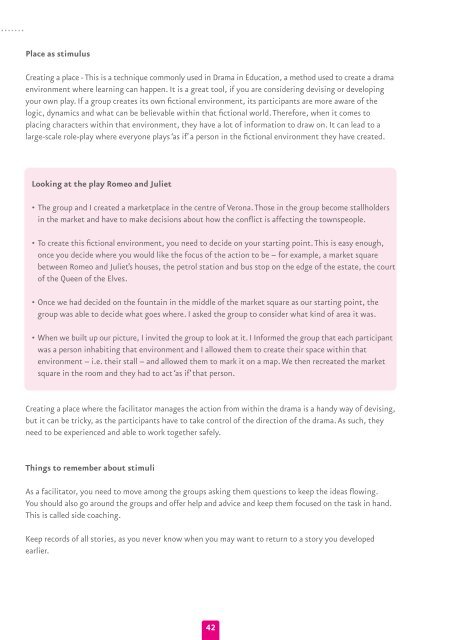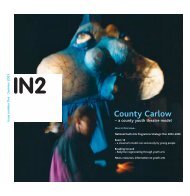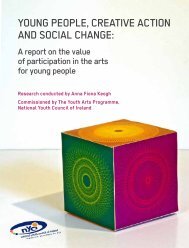DRAMA SPACES - Youth Arts Programme
DRAMA SPACES - Youth Arts Programme
DRAMA SPACES - Youth Arts Programme
Create successful ePaper yourself
Turn your PDF publications into a flip-book with our unique Google optimized e-Paper software.
dramaspaces6 18/8/05 4:25 PM Page 42Place as stimulusCreating a place - This is a technique commonly used in Drama in Education, a method used to create a dramaenvironment where learning can happen. It is a great tool, if you are considering devising or developingyour own play. If a group creates its own fictional environment, its participants are more aware of thelogic, dynamics and what can be believable within that fictional world.Therefore, when it comes toplacing characters within that environment, they have a lot of information to draw on. It can lead to alarge-scale role-play where everyone plays ‘as if’a person in the fictional environment they have created.Looking at the play Romeo and Juliet• The group and I created a marketplace in the centre of Verona.Those in the group become stallholdersin the market and have to make decisions about how the conflict is affecting the townspeople.• To create this fictional environment, you need to decide on your starting point.This is easy enough,once you decide where you would like the focus of the action to be – for example, a market squarebetween Romeo and Juliet’s houses, the petrol station and bus stop on the edge of the estate, the courtof the Queen of the Elves.• Once we had decided on the fountain in the middle of the market square as our starting point, thegroup was able to decide what goes where. I asked the group to consider what kind of area it was.• When we built up our picture, I invited the group to look at it. I Informed the group that each participantwas a person inhabiting that environment and I allowed them to create their space within thatenvironment – i.e. their stall – and allowed them to mark it on a map.We then recreated the marketsquare in the room and they had to act ‘as if’that person.Creating a place where the facilitator manages the action from within the drama is a handy way of devising,but it can be tricky, as the participants have to take control of the direction of the drama.As such, theyneed to be experienced and able to work together safely.Things to remember about stimuliAs a facilitator, you need to move among the groups asking them questions to keep the ideas flowing.You should also go around the groups and offer help and advice and keep them focused on the task in hand.This is called side coaching.Keep records of all stories, as you never know when you may want to return to a story you developedearlier.42






